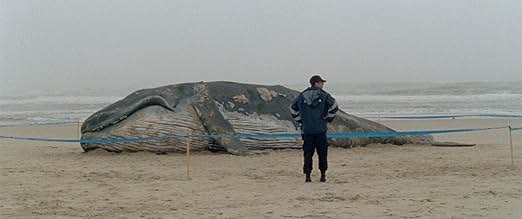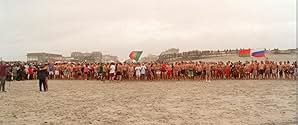VALUTAZIONE IMDb
6,9/10
2492
LA TUA VALUTAZIONE
Un'epopea adattata al Portogallo moderno che assomiglia alcuni episodi di Arabian Nights.Un'epopea adattata al Portogallo moderno che assomiglia alcuni episodi di Arabian Nights.Un'epopea adattata al Portogallo moderno che assomiglia alcuni episodi di Arabian Nights.
- Premi
- 16 vittorie e 23 candidature
Trama
Lo sapevi?
- ConnessioniFollowed by As Mil e Uma Noites - Volume 2: O Desolado (2015)
- Colonne sonoreDiferencas de Guardame las Vacas
Written and performed by José Miguel Moreno
Recensione in evidenza
A binge-watching of Portuguese auteur-in-the-making Miguel Gomes' Herculean ARABIAN NIGHTS trilogy, his fourth feature, the much-anticipated follow-up after TABU (2012), his critically acclaimed present/past diptych stunner.
Consciously informing audience beforehand with its caption - "The film is not an adaptation of the book ARABIAN NIGHTS despite drawing on its structure", the three volumes of ARABIAN NIGHTS constitute an expansive ethnic dissection of Portugal's burning mire, all the stories told by Scheherazade (Alfaiate) stem from events confined within a single calendar year from August 2013 to July 2014 in Portugal, when its people are stricken with economic austerity and become impoverished, implement by the government which Gomez denounces devoid of social justice.
Volume 1, The Restless One, presents at the get-go a documentary preamble fixates on two paralleled topics, one is the closure of a large shipyard and its ramifications of workers' layoff, another is about the exigent countermeasure to the plague of wasps which blights the local apiculture.
After a brief introduction of Scheherazade and her nightly undertaking, she starts to narrate the stories, which allegedly should be scintillating enough to keep her alive from the killing-prone king.
The Men with Hard-ons is an outré caricature, government kingpins, including the Prime Minister of Portugal (Samora), are negotiating the future of the country with several other foreign capitalists, when a magician offers a cure of their collective impotence, they all accept it but soon find the flip side of a perpetual hard-on. This allegory runs out of gas quickly being too self- conscious all the time, it seems that ridicule is not Gomez's strongest suit.
The Story of the Cockerel and the fire, is executed with a more naturalistic spin, but the magic element continues, a love triangle (impersonated by three teenagers) is behind a sagacious cockerel's early-morning crowing, which causes some legal action for the owner and concurs with the election in an arson-rampant rural town. Weaving a fly-on-the-wall approach of fabricating a tall tale into expressing social critique with a critical eye, Gomes seems to find his footing.
The third story, the Swim of the Magnificents, carries on further with this methodology, plies audience with some very stimulating visual grandeur and idiosyncrasy, a fetid clinic (looks like being built in a cavity of a dead whale), follows by a stranded whale and its sudden explosion, leaves a struggling mermaid on the beach, a culmination achieved by a throng of people celebrating New Year's Day in the fashion of winter swimming in the sea, that is the spirit, alleviating the sore generated from the previous three accounts of personal crisis caused by unemployment. Blending real and surreal, Volume One ends with a moderately impressive note.
Consciously informing audience beforehand with its caption - "The film is not an adaptation of the book ARABIAN NIGHTS despite drawing on its structure", the three volumes of ARABIAN NIGHTS constitute an expansive ethnic dissection of Portugal's burning mire, all the stories told by Scheherazade (Alfaiate) stem from events confined within a single calendar year from August 2013 to July 2014 in Portugal, when its people are stricken with economic austerity and become impoverished, implement by the government which Gomez denounces devoid of social justice.
Volume 1, The Restless One, presents at the get-go a documentary preamble fixates on two paralleled topics, one is the closure of a large shipyard and its ramifications of workers' layoff, another is about the exigent countermeasure to the plague of wasps which blights the local apiculture.
After a brief introduction of Scheherazade and her nightly undertaking, she starts to narrate the stories, which allegedly should be scintillating enough to keep her alive from the killing-prone king.
The Men with Hard-ons is an outré caricature, government kingpins, including the Prime Minister of Portugal (Samora), are negotiating the future of the country with several other foreign capitalists, when a magician offers a cure of their collective impotence, they all accept it but soon find the flip side of a perpetual hard-on. This allegory runs out of gas quickly being too self- conscious all the time, it seems that ridicule is not Gomez's strongest suit.
The Story of the Cockerel and the fire, is executed with a more naturalistic spin, but the magic element continues, a love triangle (impersonated by three teenagers) is behind a sagacious cockerel's early-morning crowing, which causes some legal action for the owner and concurs with the election in an arson-rampant rural town. Weaving a fly-on-the-wall approach of fabricating a tall tale into expressing social critique with a critical eye, Gomes seems to find his footing.
The third story, the Swim of the Magnificents, carries on further with this methodology, plies audience with some very stimulating visual grandeur and idiosyncrasy, a fetid clinic (looks like being built in a cavity of a dead whale), follows by a stranded whale and its sudden explosion, leaves a struggling mermaid on the beach, a culmination achieved by a throng of people celebrating New Year's Day in the fashion of winter swimming in the sea, that is the spirit, alleviating the sore generated from the previous three accounts of personal crisis caused by unemployment. Blending real and surreal, Volume One ends with a moderately impressive note.
- lasttimeisaw
- 1 giu 2016
- Permalink
I più visti
Accedi per valutare e creare un elenco di titoli salvati per ottenere consigli personalizzati
- How long is Arabian Nights: Volume 1 - The Restless One?Powered by Alexa
Dettagli
- Data di uscita
- Paesi di origine
- Siti ufficiali
- Lingue
- Celebre anche come
- Arabian Nights: Volume 1 - The Restless One
- Luoghi delle riprese
- Viana do Castelo, Minho, Portogallo(first part: shipyard)
- Aziende produttrici
- Vedi altri crediti dell’azienda su IMDbPro
Botteghino
- Lordo Stati Uniti e Canada
- 12.260 USD
- Lordo in tutto il mondo
- 28.245 USD
- Tempo di esecuzione2 ore 5 minuti
- Colore
- Proporzioni
- 2.35 : 1
Contribuisci a questa pagina
Suggerisci una modifica o aggiungi i contenuti mancanti

Divario superiore
By what name was As Mil e Uma Noites - Volume 1: O Inquieto (2015) officially released in India in English?
Rispondi





























